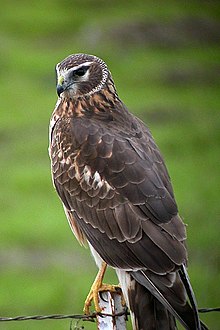
The Accipitridae is one of the three families within the order Accipitriformes, and is a family of small to large birds of prey with strongly hooked bills and variable morphology based on diet. They feed on a range of prey items from insects to medium-sized mammals, with a number feeding on carrion and a few feeding on fruit. The Accipitridae have a cosmopolitan distribution, being found on all the world's continents and a number of oceanic island groups. Some species are migratory. The family contains 255 species which are divided into 70 genera.

The hen harrier is a bird of prey. It breeds in Eurasia. The term "hen harrier" refers to its former habit of preying on free-ranging fowl.

Montagu's harrier (Circus pygargus) is a migratory bird of prey of the harrier family. Its common name commemorates the British naturalist George Montagu.
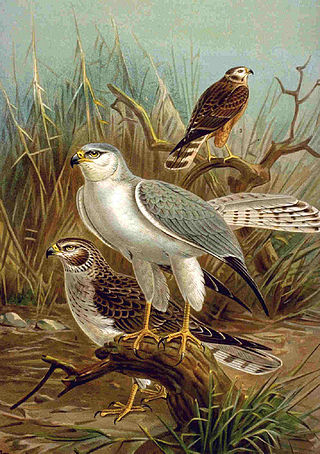
The Pallid Harrier is a migratory bird of prey of the harrier subfamily. The scientific name is derived from the Ancient Greek. Circus is from kirkos (circle), referring to a bird of prey named for its circling flight, and macrourus is "long-tailed", from makros (long) and -ouros (-tailed).

The western marsh harrier is a large harrier, a bird of prey from temperate and subtropical western Eurasia and adjacent Africa. It is also known as the Eurasian marsh harrier. Formerly, a number of relatives were included in C. aeruginosus, which was then known as "marsh harrier". The related taxa are now generally considered to be separate species: the eastern marsh harrier, the Papuan harrier of eastern Asia and the Wallacea, the swamp harrier of Australasia and the Madagascar marsh harrier of the western Indian Ocean islands.
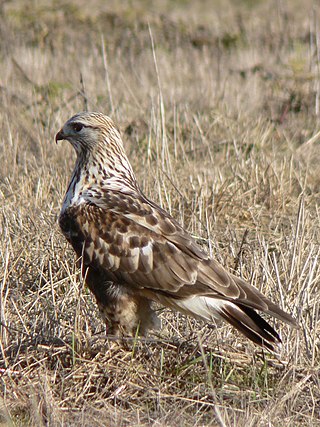
The rough-legged buzzard (Europe) or rough-legged hawk is a medium-large bird of prey. It is found in Arctic and Subarctic regions of North America, Europe, and Russia during the breeding season and migrates south for the winter. It was traditionally also known as the rough-legged falcon in such works as John James Audubon's The Birds of America.

The short-eared owl is a widespread grassland species in the family Strigidae. Owls belonging to genus Asio are known as the eared owls, as they have tufts of feathers resembling mammalian ears. These "ear" tufts may or may not be visible. The short-eared owl will display its tufts when in a defensive pose, although its very short tufts are usually not visible. The short-eared owl is found in open country and grasslands.
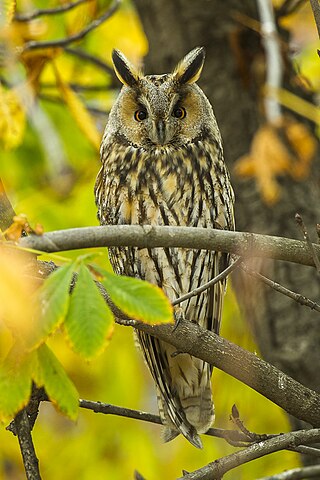
The long-eared owl, also known as the northern long-eared owl or, more informally, as the lesser horned owl or cat owl, is a medium-sized species of owl with an extensive breeding range. The scientific name is from Latin. The genus name Asio is a type of eared owl, and otus also refers to a small, eared owl. The species breeds in many areas through Europe and the Palearctic, as well as in North America. This species is a part of the larger grouping of owls known as typical owls, of the family Strigidae, which contains most extant species of owl.
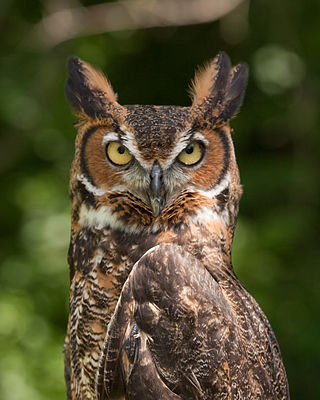
The great horned owl, also known as the tiger owl or the hoot owl, is a large owl native to the Americas. It is an extremely adaptable bird with a vast range and is the most widely distributed true owl in the Americas. Its primary diet is rabbits and hares, rats and mice, and voles, although it freely hunts any animal it can overtake, including rodents and other small mammals, larger mid-sized mammals, birds, reptiles, amphibians, and invertebrates.

The northern saw-whet owl is a species of small owl in the family Strigidae. The species is native to North America. Saw-whet owls of the genus Aegolius are some of the smallest owl species in North America. They can be found in dense thickets, often at eye level, although they can also be found some 20 ft (6.1 m) up. Saw-whets are often in danger of being preyed upon by larger birds of prey. The northern saw-whet owl is a migratory bird without any strict pattern.

The eastern screech owl or eastern screech-owl, is a small owl that is relatively common in Eastern North America, from Mexico to Canada. This species resides in most types of woodland habitats across its range, and is relatively adaptable to urban and developed areas compared to other owls. Although it often lives in close proximity to humans, the eastern screech owl frequently avoids detection due to its strictly nocturnal habits.

Cooper's hawk is a medium-sized hawk native to the North American continent and found from southern Canada to Mexico. This species is a member of the genus Accipiter, sometimes referred to as true hawks, which are famously agile, relatively small hawks common to wooded habitats around the world and also the most diverse of all diurnal raptor genera. As in many birds of prey, the male is smaller than the female. The birds found east of the Mississippi River tend to be larger on average than the birds found to the west. It is easily confused with the smaller but similar sharp-shinned hawk.

The red-tailed hawk is a bird of prey that breeds throughout most of North America, from the interior of Alaska and northern Canada to as far south as Panama and the West Indies. It is one of the most common members within the genus of Buteo in North America or worldwide. The red-tailed hawk is one of three species colloquially known in the United States as the "chickenhawk", though it rarely preys on standard-sized chickens. The bird is sometimes also referred to as the red-tail for short, when the meaning is clear in context. Red-tailed hawks can acclimate to all the biomes within their range, occurring on the edges of non-ideal habitats such as dense forests and sandy deserts. The red-tailed hawk occupies a wide range of habitats and altitudes, including deserts, grasslands, coniferous and deciduous forests, agricultural fields, and urban areas. Its latitudinal limits fall around the tree line in the subarctic and it is absent from the high Arctic. Generally it favors varied habitats with open woodland, woodland edge and open terrain. It is legally protected in Canada, Mexico, and the United States by the Migratory Bird Treaty Act.

The ferruginous hawk is a large bird of prey and belongs to the broad-winged buteo hawks. An old colloquial name is ferrugineous rough-leg, due to its similarity to the closely related rough-legged hawk.

The scarlet tanager is a medium-sized American songbird. Until recently, it was placed in the tanager family (Thraupidae), but it and other members of its genus are now classified as belonging to the cardinal family (Cardinalidae). The species' plumage and vocalizations are similar to other members of the cardinal family, although the Piranga species lacks the thick conical bill that many cardinals possess. The species resides in thick deciduous woodlands and suburbs.
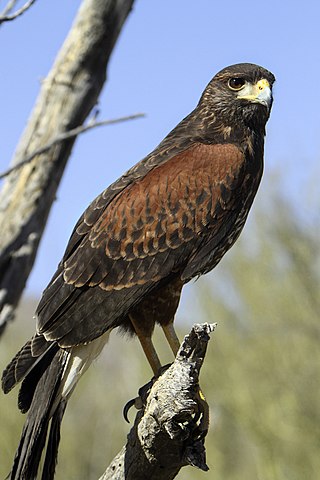
Harris's hawk, formerly known as the bay-winged hawk, dusky hawk, and sometimes a wolf hawk, and known in Latin America as peuco, is a medium-large bird of prey that breeds from the southwestern United States south to Chile, central Argentina, and Brazil. This bird is sometimes reported to be at large in Western Europe, especially Britain, but it is a popular species in falconry and these records almost invariably all refer to escapes from captivity.

The cinereous harrier is a South American bird of prey of the harrier family. Its breeding range extends from the Tierra del Fuego through Argentina and Chile to Bolivia, Paraguay, Peru and southern Brazil; and across the Andes north to Colombia. The bird's population is declining but due to its large range is not considered vulnerable. The term cinereous, deriving from the Latin word for ashy, describes its colouration.

The long-winged harrier is a common bird of prey species endemic to South America. They are members of the family Accipitridae, under the genus Circus which encompasses other harrier species. Its range encompasses most of South America, in grassland and wetland all across the continent. The long-winged harrier is a carnivorous bird, and will feed on many different animals found in its habitat. Like owls and other harrier species, the long-winged harrier has a distinctive facial disc, which is used to triangulate the bird's hearing while it is hunting.

The Eurasian goshawk is a species of medium-large bird of prey in the family Accipitridae, a family which also includes other extant diurnal raptors, such as eagles, buzzards and harriers. As a species in the genus Accipiter, the goshawk is often considered a "true hawk". The scientific name is Latin; Accipiter is "hawk", from accipere, "to grasp", and gentilis is "noble" or "gentle" because in the Middle Ages only the nobility were permitted to fly goshawks for falconry.

The gray hawk or Mexican goshawk is a smallish raptor found in open country and forest edges. It is sometimes placed in the genus Asturina as Asturina plagiata. The species was split by the American Ornithological Society (AOU) from the gray-lined hawk. The gray hawk is found from Costa Rica north into the southwestern United States.
